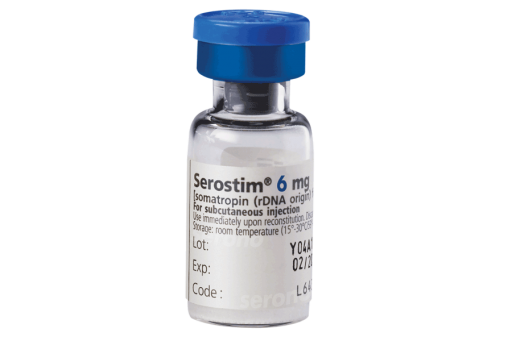Serostim
somatropin for injection

Standard Dose
0.1 mg/kg via subcutaneous (under the skin) injection, which may be in the thigh, upper arm, abdomen, or buttock once daily at bedtime (up to 6 mg), rotating injection sites and avoiding scar tissue, bruises, and the navel. It is available in 4 mg, 5 mg, and 6 mg vials. The multi-use 4 mg vial is reconstituted with bacteriostatic (containing a biological or chemical agent that stops bacteria from reproducing) water for injection and may be refrigerated for up to 14 days after reconstitution. The single-use 5 mg and 6 mg vials are reconstituted with sterile water for injection and must be used immediately; after administering the dose, any unused portion should be discarded. Some loss of the dose can be expected (approximately 10%). Inject the water into the vial aiming for the glass wall. The vial should be swirled gently in a circular motion until solution is completely dissolved; it must be clear and colorless. Do not shake. Do not inject if solution is cloudy or contains particles.Serostim is recombinant (made in a lab) human growth hormone for treatment of HIV wasting (unintentional loss of weight) or cachexia (general ill health resulting from emaciation), decreased lean body mass (muscle), and loss of physical endurance. Loss of muscle can be difficult to notice or diagnose. Serostim has been shown to increase HIV replication in the test tube; therefore, people must take anti-HIV therapy, known as HAART (or cART), in order to be prescribed Serostim.
Most common potential side effects include swelling (especially of the hands and feet), muscle pain, joint pain, numbness, and pain in extremities (the ends of limbs, especially the hands and feet), carpal tunnel syndrome (which would require discontinuation if unresolved by decreasing the number of doses), injection site reactions (pain, numbness, redness, or swelling), increased blood fat (triglycerides) and blood sugar (including new or worsening cases of diabetes, sometimes reversible upon stopping Serostim), nausea, and fatigue. More rarely, potential side effects include pancreatitis (watch for persistent severe abdominal pain) and intracranial hypertension (rise in pressure in the skull, with vision changes, headache, nausea, or vomiting). Serostim should be avoided by people who are acutely ill, have an active cancer, or have diabetic retinopathy (damage to one or both retinas). Since HIV-positive people may have an increased risk of developing new tumors, including from birthmarks or other moles, risks versus benefits of starting Serostim should always be discussed with your provider. Additionally, people with known malignancies should be carefully monitored, because Serostim may cause increased growth or malignancy changes.
Rotate injection sites to avoid injection site reactions. An injection training program is available; go to serostim.com/treatment-with-serostim or call 877-714-2947. Do not use while experiencing cancer or cancer treatment, serious injuries, severe breathing problems, certain eye diseases related to diabetes, or after critical illness due to complications of abdominal or open-heart surgery.
Manufacturer
EMD Seronoserostim.com
(877) 714-AXIS (2947)
AWP
6 mg: 7 injections (usually a one-week supply) $5,297.04Potential Side Effects and Toxicity
Most common potential side effects include swelling (especially of the hands and feet), muscle pain, joint pain, numbness, and pain in extremities (the ends of limbs, especially the hands and feet), carpal tunnel syndrome (which would require discontinuation if unresolved by decreasing the number of doses), injection site reactions (pain, numbness, redness, or swelling), increased blood fat (triglycerides) and blood sugar (including new or worsening cases of diabetes, sometimes reversible upon stopping Serostim), nausea, and fatigue. More rarely, potential side effects include pancreatitis (watch for persistent severe abdominal pain) and intracranial hypertension (rise in pressure in the skull, with vision changes, headache, nausea, or vomiting). Serostim should be avoided by people who are acutely ill, have an active cancer, or have diabetic retinopathy (damage to one or both retinas). Since HIV-positive people may have an increased risk of developing new tumors, including from birthmarks or other moles, risks versus benefits of starting Serostim should always be discussed with your provider. Additionally, people with known malignancies should be carefully monitored, because Serostim may cause increased growth or malignancy changes.
Potential Drug Interactions
Based on how the drug is broken down in your body and metabolized, there are some potential drug-drug interactions, though no formal drug studies have been conducted. These theoretically potential interactions can affect people on glucocorticoid (such as prednisone) therapy and may require an increased prednisone dose. Others may include medications that are metabolized through the CYP450 enzyme in your liver (like some antiretrovirals, cholesterol medications, or anticonvulsants); or medications such as oral estrogen, insulin, or oral diabetes drugs. Be sure to tell your provider, pharmacist, and/or other providers about all of the medications you are taking, including herbs, supplements, and over-the-counter (OTC) products, prescribed or not.
More Information
Rotate injection sites to avoid injection site reactions. An injection training program is available; go to serostim.com/treatment-with-serostim or call 877-714-2947. Do not use while experiencing cancer or cancer treatment, serious injuries, severe breathing problems, certain eye diseases related to diabetes, or after critical illness due to complications of abdominal or open-heart surgery.
CAP & PAP Information
There are several assistance programs, including the EMD Serono Secured Distribution Program, the AXIS Center, the Serostim Patient Assistance Program (PAP) or the Co-Pay Assistance Program (CAP). To find out more about these programs, call (877) 714-2947.
This year, the co-pay card is frontloaded. $0 initial fill (rebate form provided if you need to pay up front and are eligible), and up to $1,500 for each additional monthly fill, not to exceed $18,000/year. PAP also available if you qualify. Call AXIS Center (877) 714-AXIS (2947).
Go to serostim.com, refreshed this year with more healthy living resources, injection tips, and advice for talking with your provider. See also hivwasting.com.


